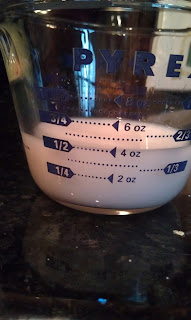The best way to monitor portion sizes is literally to weigh and measure your food. What a pain, right? Not really. It doesn't take much time (though it does add a few extra dishes) and the big payoff is you actually KNOW how many calories you are consuming. For weight loss or even maintenance, knowing how many calories are in a bowl of cereal or a serving of yogurt can be the difference between gaining and losing.
Yesterday, for example, I made myself a granola-yogurt-rice milk-blackberry breakfast mess. Before I started I pulled everything out and looked at the serving sizes and calories on the side of the boxes. Here is something I found interesting: the serving size for the yogurt (plain-low fat) was 1 cup. The serving size for the granola was 3/4 of a cup.
I measured out 3/4 of a cup of granola and realized that I didn't want anywhere near as much yogurt as a full serving of 1 cup. I measured out less than 3/4 cup (I used the same measuring cup) and it was really still more that what I needed. The rice milk was the same way. A serving was a half cup, but I only wanted a splash to help soften the granola. I measured out a half a cup to see how much it really was, and then poured into my bowl the amount I wanted. Turned out I really only had less than a 1/4 cup of rice milk on my cereal.
So here is my point: if I would have just used the measurements on the serving size I would have had more calories than I really needed and more food than I actually wanted. By paying attention I managed to avoid nearly 200 (!!) calories in my breakfast. For someone that is only 5'4" tall and for weight loss should only be consuming about 1300-1500 calories per day, an extra 200 calories per meal is A LOT.
So here are some pictures of ACTUAL portions of ACTUAL food.
Fill a standard size shot glass with nuts and you have a ounce serving.
Measure out your cereal and milk based on the serving size on the box.
This is what a serving size of cereal looks like in my regular bowl.
Turns out I don't use a serving of rice milk for my cereal...I use about a half a serving. Good to know!
Here is where it can get really interesting. In the photo below is an "average" size pre-frozen chicken breast with rib meat. I purchased this from Trader Joe's in the frozen section in a bag. I weighed and measured several pieces. One was over 8.5 ounces, but most were in the 7 ounce range.
A serving size portion of meat should be about 3 (!!) ounces. Which means, if you grab a chicken breast from the frozen bag, or even fresh from the packs in your grocery meat section, cook it up and serve it to yourself, you are very likely getting at least TWICE the portion recommended.
And, if you are watching calories, they add up quickly in things like meats, nuts and grains! The above picture is a 5 ounce piece of chicken breast. The picture below is actually a perfect 3 ounces of chicken breast.
Compare the size of my hand to the appropriate portion size.
Now look at the difference between what comes in the package and the appropriate portion size again. Look how much of the plate (regular size dinner plate) this piece takes up compared to the one above.
And what does it really mean calorie wise?
An extra 110 calories when you are trying to monitor your calories and lose weight, every day, adds up to 770 calories per week. To lose a pound of fat you need to reduce your calories by 3500 per week over your baseline metabolic calorie need. So you can see how easy it is for a little extra here or there to add up and prevent you from losing weight, or worse, how easy it is to cause weight gain!
I will be talking more about this in the coming days and weeks, but for now, just think about it. Pay a little more attention. How much creamer are you *really* putting in your coffee? Is it really a tablespoon or are you adding a 1/4 cup or more? All those splashes, dashes, and smidges add up over time.
Do you eyeball your portions?









2 comments:
Its almost better to eat off a child's plate when you think of it. My "eyeballing" it is much larger than it should be. lol.
They say small plates are very useful for portion control. I have used that technique in the past and have started reincorporating that into my portion control plan as well recently.
Post a Comment